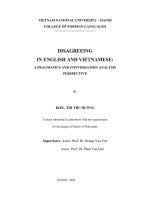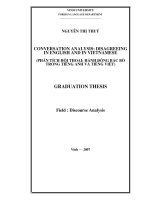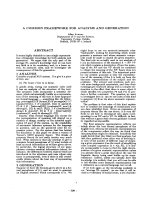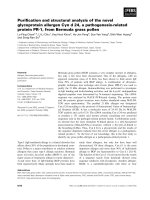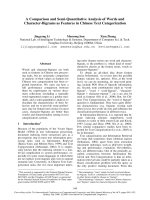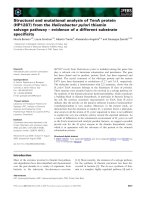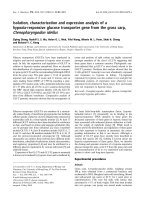A pragmatics and conversation analysis perspective
Bạn đang xem bản rút gọn của tài liệu. Xem và tải ngay bản đầy đủ của tài liệu tại đây (1.07 MB, 249 trang )
VIETNAM NATIONAL UNIVERSITY – HANOI
COLLEGE OF FOREIGN LANGUAGES
DISAGREEING
IN ENGLISH AND VIETNAMESE:
A PRAGMATICS AND CONVERSATION ANALYSIS
PERSPECTIVE
By
KIEU, THI THU HUONG
A thesis submitted in conformity with the requirements
for the degree of Doctor of Philosophy
Supervisors: Assoc. Prof. Dr. Hoang Van Van
Assoc. Prof. Dr. Phan Van Que
HANOI - 2006
CERTIFICATE OF ORIGINALITY
I certify my authority of the study project report submitted entitled
DISAGREEING IN ENGLISH AND VIETNAMESE:
A PRAGMATICS AND CONVERSATION ANALYSIS PERSPECTIVE
In fulfillment of the requirements for the degree of Doctor of Philosophy
Except where the reference is indicated, no other person’s work has been used
without due acknowledgment in the text of the thesis.
Hanoi - 2006
Kieu Thi Thu Huong
ACKNOWLEDGEMENTS
I am indebted to many people without whose help the present thesis could not have been
completed. First of all, I would like to express my sincere gratitude to my supervisors
Assoc. Prof. Dr. Hoang Van Van and Assoc. Prof. Dr. Phan Van Que for their invaluable
guidance, insightful comments and endless support.
I wish to express my deep indebtedness to Prof. Dr. Luong Van Hy, the chair of the
Department of Anthropology, University of Toronto, Canada for his brilliant scholarship,
demanding teaching and supervision. His unending help greatly encouraged me before and
during my one-year study at this university. I am most grateful to Assoc. Prof. Dr. Sidnell,
who worked at UCLA for some time with Schegloff, one of the founders of conversation
analysis, for his productive course of conversation analysis, his kindness and generosity in
providing naturally occurring data and responding literature.
I am deeply thankful to Assoc. Prof. Dr. Nguyen Quang for his invaluable suggestions, and
helpful advice. I have greatly benefited from his scholarship, encouragement and
generosity. I would like to take this opportunity to thank Assoc. Prof. Dr. Nguyen Hoa for
his discerning comments, knowledgeable suggestions and kind-heartedness. My sincere
thanks go to all my teachers at CFL – VNU for their profound knowledge and outstanding
teaching during my long study at the Department of Graduate Studies (DGS) from 1998 to
2005.
My special thanks are due to Ms Sandra Harrison, the country director of ELI Vietnam for
her kind support and valuable correction of all this work in manuscript. But for her, I would
not have had any access to ELI teachers working in Vietnam.
i
My thanks are also extended to all my informants in Hanoi and North America, my friends
and students, my colleagues at Hanoi-Amsterdam High school, the school principal Mr. Do
Lenh Dien, and all the people who have assisted my research work, especially Dr. Ngo Huu
Hoang and the DGS staff. To Assoc. Prof. Dr. Le Hung Tien, the chair of the DGS, I
extend my enormous gratitude for his scholarship and sincerity.
I sincerely thank Dr. Vu Thi Thanh Huong at the Institute of Linguistics for her efficient
assistance, intellectual support and continual encouragement.
I especially express my heartfelt gratitude to Assoc. Prof. Dr. Tran Huu Manh, who
supervised my MA thesis, which is considered the very first step to the present Ph.D.
dissertation, for his distinctive guidance, constant encouragement and benevolence.
Finally, I owe the completion of this dissertation to my parents and my siblings, my
husband and my two children, who have always given me their love, understanding and
encouragement throughout my study.
To all mentioned, and to many more, my heart extends the warmest thanks.
ii
ABSTRACT
This thesis takes as its main objective the description of the native perception and
realization of the speech act of disagreeing in English and Vietnamese within the
theoretical frameworks of pragmatics and conversation analysis and the help of SPSS,
version 11.5, a software program for social sciences. It aims at yielding insights into such
issues as politeness, its notions and relations with indirectness, strategies and linguistic
devices used to express disagreement tokens in the English and Vietnamese languages and
cultures. Linguistic politeness is carefully examined in its unity of discernment and volition
on the basis of the data obtained from elicited written questionnaires, folk expressions,
interviews and naturally occurring interactions. The meticulous and miraculous methods
offered by conversation analysis are of great help in describing and exploring the structural
organization of disagreement responses in preferred and dispreferred format, the
relationships between disagreements and the constraint systems, and negotiation of
disagreements by native speakers.
The findings exhibit that the differences in choosing politeness strategies to perform
disagreements by speakers of English in North America and speakers of Vietnamese in
Hanoi result from the differences in their assessment of socio-cultural parameters and
social situations. Although indirectness might be used in some contexts as a means to
express politeness, there is no absolute correlation between politeness and indirectness in
the two languages and cultures under investigation. Despite the English general preference
for direct strategies and the Vietnamese tendency to indirect strategies, the former may be
indirect in some contexts and the latter are prone to be direct or even very direct from time
to time. Consequently, the study of politeness should be conducted in close relation to the
iii
study of the speakers’ wider socio-cultural milieus with systems of local norms, beliefs and
values. In proffering disagreements to the prior evaluations or ideas, native speakers not
only deploy individually volitional strategies but also observe socially determined norms of
behavior, especially in the choice of formulaic expressions, speech levels, address terms,
deference markers etc. Therefore, the deployment of the normative-volitional approach to
politeness study is appropriate and reasonable.
Conversation analysis sheds light on disagreements as dispreferred seconds to first
assessments and opinions, and as preferred seconds to self-deprecations. English and
Vietnamese speakers adopt the same strategies in regards to preference organization,
compliment responses and negotiation of disagreements. On the whole, disagreements are
inclined to be hedged or delayed by a variety of softeners and/or other devices. However,
they tend to be overtly stated in responses to self-denigrations. It is of interest to explore
the conflicting effects caused by the correlation between preference organization and self-
compliment avoidance in responses to compliments. The English informants show a trend
towards compliment acceptance and appreciation, while the Vietnamese prefer to refuse
and negate prior complimentary tokens in spite of their similar strategies in adopting mid-
positions. The accounts for this phenomenon can be found in the Vietnamese community-
based solidarity and the Anglophone individualistic satisfaction. Conversation analytic
tools help highlight the use of address terms (in Vietnamese), intensifiers (in English and
Vietnamese) and other supportive means. By and large, the combined pragmatics and
conversation analysis perspective is strongly recommended to speech act study as this
integration maximizes the strengths and minimizes the weaknesses of each approach.
iv
TABLE OF CONTENTS
KIEU THI THU HUONG.....................................................................................................II
ACKNOWLEDGEMENTS...................................................................................................I
ABSTRACT..........................................................................................................................III
TABLE OF CONTENTS......................................................................................................V
LIST OF TABLES AND CHARTS...................................................................................XII
Table 1-1: The five general functions of speech acts (Yule 1996:
55) 16..........................................................................................xii
Table 1-2: Gender correlation between English and Vietnamese
respondents 32............................................................................xii
Table 1-3: Age group correlation between English and
Vietnamese respondents 33........................................................xii
Table 1-4: Assessment of socio-cultural factors: Age of co-
conversants 37............................................................................xii
Table 1-5: Assessment of socio-cultural factors: Manner of
communication 38......................................................................xii
Table 1-6: Assessment of socio-cultural factors: Setting 39.....xii
Table 1-7: Assessment of socio-cultural factors: Gender of co-
conversants 39............................................................................xii
Table 1-8: Assessment of socio-cultural factors: Social status 40
....................................................................................................xii
Table 1-9: Assessment of socio-cultural factors: Length of time
you know your co-conversants 42.............................................xii
Table 1-10: Assessment of Social Situations - Sit. A1. Praise on
Nice-looking Spouse 44.............................................................xii
Table 1-11: Assessment of Social Situations - Sit. A2. Self-
praise on New Hairstyle 45........................................................xii
Table 1-12: Assessment of Social Situations - Sit. A3.
Disparagement of New Italian Shoes 45....................................xii
Table 1-13: Assessment of Social Situations - Sit. A4. Miss X Is
Getting Too Fat 45.....................................................................xii
Table 1-14: Assessment of Social Situations - Sit. B2. Bigger
Pensions 46.................................................................................xii
Table 1-15: Assessment of Social Situations - Sit. C1. Mr. Y's
Promotion 46..............................................................................xii
Table 1-16: Assessment of Social Situations - Sit. C4. Voting
for Mr. X 47................................................................................xii
Table 1-17: Assessment of Social Situations - Sit. D1. Car
Expert 47....................................................................................xii
Table 1-18: Assessment of Social Situations - Sit. D2. Favorite
Team's Failure 48.......................................................................xii
v
Table 1-19: General Assessment of All Situations by
Respondents 49.........................................................................xiii
Table 2-20: Assessment of Politeness Level. 4.1. 'She's all right,
I suppose.' 71.............................................................................xiii
Table 2-21: Assessment of Politeness Level. 4.3. 'Fashions
change, you know.' 72...............................................................xiii
Table 2-22: Assessment of Politeness Level. 4.4. ‘We’re very
much in agreement, but ….' 73.................................................xiii
Table 2-23: Assessment of Politeness Level. 4.5. 'Not me, I
totally disagree. ' 74..................................................................xiii
Table 2-24: Assessment of Politeness Level. 4.6. 'That's pretty
good.' 74....................................................................................xiii
Table 2-25: Assessment of Politeness Level. 4.7. 'That may be
so, but....' 76..............................................................................xiii
Table 2-26: Assessment of Politeness Level. 4.8. ‘Really?’ 77
...................................................................................................xiii
Table 2-27: Assessment of Politeness Level. 4.9. 'No, grandpa,
no, no, you're wrong.' 77...........................................................xiii
Table 2-28: Assessment of Politeness Level. 4.10. 'Boring
people get bored.' 78.................................................................xiii
Table 2-29: Assessment of Politeness Level. 4. 11. 'Do you
really think so?' 78....................................................................xiii
Table 2-30: Assessment of Politeness Level. 4.12. 'Sorry, but I
think it was interesting.' 79.......................................................xiii
Table 3-31: Choice of Politeness Strategies to Disagree with
Close Friend (Miss X is fat) 104...............................................xiii
Table 3-32: Choice of Politeness Strategies to Disagree with
Close Friend (Tax increase) 105...............................................xiii
Table 3-33: Choice of Politeness Strategies to Disagree with
Close Friend (Boring party) 106...............................................xiii
Table 3-34: Choice of Politeness Strategies to Disagree with
Someone You Dislike (Miss X is fat) 107................................xiii
Table 3-35: Choice of Politeness Strategies to Disagree with
Someone You Dislike (Tax increase) 107................................xiii
Table 3-36: Choice of Politeness Strategies to Disagree with
Someone You Dislike (Boring party) 108................................xiii
Table 3-37: Choice of Politeness Strategies to Disagree with
Colleague, same age & gender (Miss X) 109...........................xiii
Table 3-38: Choice of Politeness Strategies to Disagree with
Colleague, same age & gender (Tax) 109.................................xiv
Table 3-39: Choice of Politeness Strategies to Disagree with
Colleague, same age & gender (Party) 109..............................xiv
Table 3-40: Choice of Politeness Strategies to Disagree with
Older Acquaintance (Miss X is fat) 111...................................xiv
Table 3-41: Choice of Politeness Strategies to Disagree with
Older Acquaintance (Tax increase) 111...................................xiv
vi
Table 3-42: Choice of Politeness Strategies to Disagree with
Older Acquaintance (Boring party) 112...................................xiv
Table 3-43: Choice of Politeness Strategies to Disagree with
Older Boss (Miss X is fat) 112..................................................xiv
Table 3-44: Choice of Politeness Strategies to Disagree with
Older Boss (Tax increase) 113..................................................xiv
Table 3-45: Choice of Politeness Strategies to Disagree with
Older Boss (Boring Party) 114..................................................xiv
Table 4-46: Correlations of content and format in adjacency pair
second 121.................................................................................xiv
Table 4-47: The preference ranking of the repair apparatus
(Based on Levinson 1983: 341) 127.........................................xiv
Table 5-48: Interrelatedness between acceptances/agreements
and rejections/disagreements 159.............................................xiv
Chart 2-1: Assessment of Politeness Level. 4.1. 'She's all right, I
suppose.' 71..............................................................................xiv
Chart 2-2: Assessment of Politeness Level. 4.3. 'Fashions
change, you know.' 72...............................................................xiv
Chart 2-3: Assessment of Politeness Level. 4.4. 'We're very
much in agreement, but ....' 73..................................................xiv
Chart 2-4: Assessment of Politeness Level. 4.5. 'Not me, I
totally disagree.' 74....................................................................xiv
Chart 2-5: Assessment of Politeness Level. 4.6. 'That's pretty
good.' 75....................................................................................xiv
Chart 2-6: Assessment of Politeness Level. 4.7. 'That may be so,
but....' 75....................................................................................xiv
Chart 2-7: Assessment of Politeness Level. 4.8. 'Really?' 76...xiv
Chart 2-8: Assessment of Politeness Level. 4.9. 'No, grandpa,
no, no, you're wrong.' 77...........................................................xiv
Chart 2-9: Assessment of Politeness Level. 4.10. 'Boring people
get bored.’ 78..............................................................................xv
Chart 2-10: Assessment of Politeness Level. 4.11. 'Do you really
think so?' 79................................................................................xv
Chart 2-11: Assessment of Politeness Level. 4.12. 'Sorry, but I
think it was interesting.' 80.........................................................xv
Chart 3-12: Possible strategies for doing FTAs 84....................xv
Chart 3-13: Choice of Politeness Strategies to Disagree with
Close Friend (Miss X is fat) 104................................................xv
Chart 3-14: Choice of Politeness Strategies to Disagree with
Close Friend (Tax increase) 105................................................xv
Chart 3-15: Choice of Politeness Strategies to Disagree with
Close Friend (Boring party) 106................................................xv
Chart 3-16: Choice of Politeness Strategies to Disagree with
Someone You Dislike (Miss X is fat) 106.................................xv
Chart 3-17: Choice of Politeness Strategies to Disagree with
Someone You Dislike (Tax increase) 107.................................xv
vii
Chart 3-18: Choice of Politeness Strategies to Disagree with
Someone You Dislike (Boring party) 108.................................xv
Chart 3-19: Choice of Politeness Strategies to Disagree with
Colleague, same age & gender (Miss X) 108............................xv
Chart 3-20: Choice of Politeness Strategies to Disagree with
Colleague, same age & gender (Tax) 109..................................xv
Chart 3-21: Choice of Politeness to Disagree with Colleague,
same age & gender (Party) 110..................................................xv
Chart 3-22: Choice of Politeness Strategies to Disagree with
Older Acquaintance (Miss X is fat) 110....................................xv
Chart 3-23: Choice of Politeness Strategies to Disagree with
Older Acquaintance (Tax increase) 111.....................................xv
Chart 3-24: Choice of Politeness Strategies to Disagree with
Older Acquaintance (Boring party) 112.....................................xv
Chart 3-25: Choice of Disagreeing Strategies to Disagree with
Older Boss (Miss X is fat) 113...................................................xv
Chart 3-26: Choice of Politeness Strategies to Disagree with
Older Boss (Tax increase) 114...................................................xv
Chart 3-27: Choice of Politeness Strategies to Disagree with
Older Boss (Boring Party) 114...................................................xv
ABBREVIATIONS AND CONVENTIONS...................................................................XVI
INTRODUCTION..................................................................................................................1
CHAPTER ONE...................................................................................................................14
DISAGREEING – A COMMUNICATIVE ILLOCUTIONARY AND SOCIAL ACT 14
1.1.THEORETICAL PRELIMINARIES..........................................................................................14
1.1.1.Speech Act Theory................................................................................................14
1.1.1.1. Speech acts and speech events.....................................................................14
1.1.1.2. Three-dimension speech acts........................................................................15
1.1.1.3. Classification of speech acts.........................................................................16
1.1.1.4. Disagreeing – a communicative illocutionary act .......................................18
1.1.2.Conversation Analysis..........................................................................................20
1.1.2.1. Historical background..................................................................................20
1.1.2.2. Co-text and context.......................................................................................22
1.1.2.3. Turn – turn taking and adjacency pairs........................................................24
1.1.2.4. Disagreeing – a social act.............................................................................27
1.1.3. Summary..............................................................................................................29
1.2. EMPIRICAL STUDY.........................................................................................................29
1.2.1. Aims and methodology........................................................................................29
1.2.1.1. Aims .............................................................................................................29
1.2.1.2. Data collection methods and respondents....................................................29
1.2.2. Assessment of socio-cultural parameters by respondents..................................36
1.2.2.1. Data results...................................................................................................36
1.2.2.2. Comments.....................................................................................................43
1.2.3. Assessment of situations by respondents.............................................................44
viii
1.2.3.1. Data results...................................................................................................44
1.2.3.2. Comments.....................................................................................................48
1.2.4. Summary .............................................................................................................50
1.3. CONCLUDING REMARKS.................................................................................................51
CHAPTER TWO..................................................................................................................52
POLITENESS IN DISAGREEING ...................................................................................52
2.1. THEORETICAL PRELIMINARIES.........................................................................................52
2.1.1. Notion of Politeness.............................................................................................53
2.1.2. Volitional Approach............................................................................................55
2.1.2.1. Grice’s principle...........................................................................................55
2.1.2.2. Lakoff’s rules and Leech’s maxims.............................................................56
2.1.2.3. Brown & Levinson’s model.........................................................................58
2.1.3. Normative Approach...........................................................................................60
2.1.3.1. Chinese research...........................................................................................60
2.1.3.2. Japanese research..........................................................................................62
2.1.3.3. Other non-Anglophone research .................................................................63
2.1.4. Normative-Volitional Approach..........................................................................64
2.1.4.1. Literature by Vietnamese researchers..........................................................64
2.1.4.2. Literature by other researchers.....................................................................67
2.1.5 Summary...............................................................................................................69
2.2. EMPIRICAL STUDY.........................................................................................................70
2.2.1. Aims and Methodology .......................................................................................70
2.2.1.1. Aims..............................................................................................................70
2.2.1.2. Data collection methods and respondents....................................................70
2.2.2. Politeness Level Rated by Respondents..............................................................70
2.2.2.1. Data results...................................................................................................70
2.2.2.2. Comments.....................................................................................................80
2.2.3. Summary..............................................................................................................81
2.3. CONCLUDING REMARKS.................................................................................................81
CHAPTER THREE.............................................................................................................83
STRATEGIES OF POLITENESS IN DISAGREEING..................................................83
3.1. THEORETICAL PRELIMINARIES.........................................................................................83
3.1.1. Brown & Levinson’s Model of Strategies...........................................................83
3.1.2. Manipulation of Strategies..................................................................................84
3.1.2.1. Bald-on-record strategies..............................................................................84
3.1.2.2. On-record strategies .....................................................................................87
3.1.2.3. Off-record strategies.....................................................................................89
3.1.2.4. No FTA.........................................................................................................94
3.1.3. Indirectness in Disagreeing................................................................................95
3.1.3.1. Notion of indirectness...................................................................................95
3.1.3.2. Factors governing indirectness.....................................................................97
3.1.3.3. Indirectness and politeness...........................................................................98
3.1.4. Summary............................................................................................................102
3.2. EMPIRICAL STUDY.......................................................................................................103
ix
3.2.1. Aims and Methodology......................................................................................103
3.2.1.1. Aims............................................................................................................103
3.2.1.2. Data collection methods and respondents..................................................103
3.2.2. Choice of Strategies by Respondents................................................................104
3.2.2.1. Data results.................................................................................................104
3.2.2.2. Comments...................................................................................................115
3.2.3. Summary............................................................................................................115
3.3. CONCLUDING REMARKS...............................................................................................116
CHAPTER FOUR..............................................................................................................118
STRATEGIES CONCERNING PREFERENCE ORGANIZATION..........................118
4.1. THEORETICAL PRELIMINARIES.......................................................................................118
4.1.1. Preferred Second Turns....................................................................................118
4.1.1.1. Markedness.................................................................................................118
4.1.1.2. Structural organization...............................................................................119
4.1.1.3. Dispreferred second turns in disagreeing...................................................121
4.1.2. Preferred Sequences..........................................................................................125
4.1.2.1. Repair apparatus.........................................................................................125
4.1.2.2. Repair apparatus in disagreeing.................................................................130
4.1.3. Summary............................................................................................................133
4.2. EMPIRICAL STUDY.......................................................................................................133
4.2.1. Aims and Methodology .....................................................................................133
4.2.1.1. Aims............................................................................................................133
4.2.1.2. Data collection methods and respondents..................................................134
4.2.2. Strategies for Disagreements as Dispreferred Seconds...................................137
4.2.2.1. English corpus............................................................................................137
4.2.2.2. Vietnamese corpus......................................................................................140
4.2.2.3. Comments...................................................................................................147
4.2.3. Strategies for Disagreements as Preferred Seconds........................................148
4.2.3.1. English corpus............................................................................................148
4.2.3.2. Vietnamese corpus......................................................................................151
4.2.3.3. Comments...................................................................................................156
4.2.4. Summary............................................................................................................157
4.3. CONCLUDING REMARKS...............................................................................................157
CHAPTER FIVE................................................................................................................159
STRATEGIES FOR CONSTRAINT SYSTEMS AND NEGOTIATION OF
DISAGREEMENTS...........................................................................................................159
5.1. THEORETICAL PRELIMINARIES.......................................................................................159
5.1.1. Constraint Systems............................................................................................159
5.1.2. Negotiation of Disagreements...........................................................................160
5.1.2.1. Insertion sequences.....................................................................................161
5.1.2.2. Summons-answer sequences......................................................................161
5.1.2.3. Pre-sequences.............................................................................................162
5.1.2.4. Sequences in disagreeing............................................................................165
5.1.3. Some Frequently Used Devices in Disagreements ..........................................167
x
5.1.3.1. Intensifiers..................................................................................................167
5.1.3.2. Person referring terms................................................................................169
5.1.4. Summary............................................................................................................173
5.2. EMPIRICAL STUDY.......................................................................................................174
5.2.1. Aims and Methodology......................................................................................174
5.2.1.1. Aims............................................................................................................174
5.2.1.2. Data collection methods and respondents..................................................174
5.2.2. Strategies for Constraint Systems.....................................................................175
5.2.2.1. English corpus............................................................................................175
5.2.2.2. Vietnamese corpus......................................................................................177
5.2.3. Strategies for Negotiation of Disagreements....................................................181
5.2.3.1. English corpus............................................................................................181
5.2.3.2. Vietnamese corpus......................................................................................184
5.2.4. Summary............................................................................................................190
5.3. CONCLUDING REMARKS...............................................................................................191
CONCLUSION...................................................................................................................193
APPENDIXES.........................................................................................................................I
APPENDIX 1......................................................................................................................I
TRANSCRIPTION CONVENTIONS..................................................................................................I
APPENDIX 2....................................................................................................................III
SURVEY QUESTIONNAIRES.......................................................................................................III
BIBLIOGRAPHY.............................................................................................................XIII
ENGLISH........................................................................................................................XIII
VIETNAMESE............................................................................................................XXVIII
xi
LIST OF TABLES AND CHARTS
TABLE 1-1: THE FIVE GENERAL FUNCTIONS OF SPEECH ACTS (YULE 1996:
55)...........................................................................................................................................16
TABLE 1-2: GENDER CORRELATION BETWEEN ENGLISH AND
VIETNAMESE RESPONDENTS......................................................................................32
TABLE 1-3: AGE GROUP CORRELATION BETWEEN ENGLISH AND
VIETNAMESE RESPONDENTS......................................................................................33
TABLE 1-4: ASSESSMENT OF SOCIO-CULTURAL FACTORS: AGE OF CO-
CONVERSANTS..................................................................................................................37
TABLE 1-5: ASSESSMENT OF SOCIO-CULTURAL FACTORS: MANNER OF
COMMUNICATION...........................................................................................................38
TABLE 1-6: ASSESSMENT OF SOCIO-CULTURAL FACTORS: SETTING...........39
TABLE 1-7: ASSESSMENT OF SOCIO-CULTURAL FACTORS: GENDER OF CO-
CONVERSANTS..................................................................................................................39
TABLE 1-8: ASSESSMENT OF SOCIO-CULTURAL FACTORS: SOCIAL STATUS
................................................................................................................................................40
TABLE 1-9: ASSESSMENT OF SOCIO-CULTURAL FACTORS: LENGTH OF
TIME YOU KNOW YOUR CO-CONVERSANTS..........................................................42
TABLE 1-10: ASSESSMENT OF SOCIAL SITUATIONS - SIT. A1. PRAISE ON
NICE-LOOKING SPOUSE................................................................................................44
TABLE 1-11: ASSESSMENT OF SOCIAL SITUATIONS - SIT. A2. SELF-PRAISE
ON NEW HAIRSTYLE.......................................................................................................45
TABLE 1-12: ASSESSMENT OF SOCIAL SITUATIONS - SIT. A3.
DISPARAGEMENT OF NEW ITALIAN SHOES...........................................................45
TABLE 1-13: ASSESSMENT OF SOCIAL SITUATIONS - SIT. A4. MISS X IS
GETTING TOO FAT...........................................................................................................45
TABLE 1-14: ASSESSMENT OF SOCIAL SITUATIONS - SIT. B2. BIGGER
PENSIONS............................................................................................................................46
TABLE 1-15: ASSESSMENT OF SOCIAL SITUATIONS - SIT. C1. MR. Y'S
PROMOTION.......................................................................................................................46
TABLE 1-16: ASSESSMENT OF SOCIAL SITUATIONS - SIT. C4. VOTING FOR
MR. X.....................................................................................................................................47
TABLE 1-17: ASSESSMENT OF SOCIAL SITUATIONS - SIT. D1. CAR EXPERT 47
TABLE 1-18: ASSESSMENT OF SOCIAL SITUATIONS - SIT. D2. FAVORITE
TEAM'S FAILURE..............................................................................................................48
xii
TABLE 1-19: GENERAL ASSESSMENT OF ALL SITUATIONS BY
RESPONDENTS..................................................................................................................49
TABLE 2-20: ASSESSMENT OF POLITENESS LEVEL. 4.1. 'SHE'S ALL RIGHT, I
SUPPOSE.'............................................................................................................................71
TABLE 2-21: ASSESSMENT OF POLITENESS LEVEL. 4.3. 'FASHIONS
CHANGE, YOU KNOW.'....................................................................................................72
TABLE 2-22: ASSESSMENT OF POLITENESS LEVEL. 4.4. ‘WE’RE VERY MUCH
IN AGREEMENT, BUT ….'...............................................................................................73
TABLE 2-23: ASSESSMENT OF POLITENESS LEVEL. 4.5. 'NOT ME, I
TOTALLY DISAGREE. '....................................................................................................74
TABLE 2-24: ASSESSMENT OF POLITENESS LEVEL. 4.6. 'THAT'S PRETTY
GOOD.'..................................................................................................................................74
TABLE 2-25: ASSESSMENT OF POLITENESS LEVEL. 4.7. 'THAT MAY BE SO,
BUT....'...................................................................................................................................76
TABLE 2-26: ASSESSMENT OF POLITENESS LEVEL. 4.8. ‘REALLY?’...............77
TABLE 2-27: ASSESSMENT OF POLITENESS LEVEL. 4.9. 'NO, GRANDPA, NO,
NO, YOU'RE WRONG.'.....................................................................................................77
TABLE 2-28: ASSESSMENT OF POLITENESS LEVEL. 4.10. 'BORING PEOPLE
GET BORED.'......................................................................................................................78
TABLE 2-29: ASSESSMENT OF POLITENESS LEVEL. 4. 11. 'DO YOU REALLY
THINK SO?'.........................................................................................................................78
TABLE 2-30: ASSESSMENT OF POLITENESS LEVEL. 4.12. 'SORRY, BUT I
THINK IT WAS INTERESTING.'.....................................................................................79
TABLE 3-31: CHOICE OF POLITENESS STRATEGIES TO DISAGREE WITH
CLOSE FRIEND (MISS X IS FAT).................................................................................104
TABLE 3-32: CHOICE OF POLITENESS STRATEGIES TO DISAGREE WITH
CLOSE FRIEND (TAX INCREASE)..............................................................................105
TABLE 3-33: CHOICE OF POLITENESS STRATEGIES TO DISAGREE WITH
CLOSE FRIEND (BORING PARTY).............................................................................106
TABLE 3-34: CHOICE OF POLITENESS STRATEGIES TO DISAGREE WITH
SOMEONE YOU DISLIKE (MISS X IS FAT)...............................................................107
TABLE 3-35: CHOICE OF POLITENESS STRATEGIES TO DISAGREE WITH
SOMEONE YOU DISLIKE (TAX INCREASE)............................................................107
TABLE 3-36: CHOICE OF POLITENESS STRATEGIES TO DISAGREE WITH
SOMEONE YOU DISLIKE (BORING PARTY)...........................................................108
TABLE 3-37: CHOICE OF POLITENESS STRATEGIES TO DISAGREE WITH
COLLEAGUE, SAME AGE & GENDER (MISS X).....................................................109
xiii
TABLE 3-38: CHOICE OF POLITENESS STRATEGIES TO DISAGREE WITH
COLLEAGUE, SAME AGE & GENDER (TAX)..........................................................109
TABLE 3-39: CHOICE OF POLITENESS STRATEGIES TO DISAGREE WITH
COLLEAGUE, SAME AGE & GENDER (PARTY).....................................................109
TABLE 3-40: CHOICE OF POLITENESS STRATEGIES TO DISAGREE WITH
OLDER ACQUAINTANCE (MISS X IS FAT)...............................................................111
TABLE 3-41: CHOICE OF POLITENESS STRATEGIES TO DISAGREE WITH
OLDER ACQUAINTANCE (TAX INCREASE)............................................................111
TABLE 3-42: CHOICE OF POLITENESS STRATEGIES TO DISAGREE WITH
OLDER ACQUAINTANCE (BORING PARTY)...........................................................112
TABLE 3-43: CHOICE OF POLITENESS STRATEGIES TO DISAGREE WITH
OLDER BOSS (MISS X IS FAT)......................................................................................112
TABLE 3-44: CHOICE OF POLITENESS STRATEGIES TO DISAGREE WITH
OLDER BOSS (TAX INCREASE)...................................................................................113
TABLE 3-45: CHOICE OF POLITENESS STRATEGIES TO DISAGREE WITH
OLDER BOSS (BORING PARTY)..................................................................................114
TABLE 4-46: CORRELATIONS OF CONTENT AND FORMAT IN ADJACENCY
PAIR SECOND...................................................................................................................121
TABLE 4-47: THE PREFERENCE RANKING OF THE REPAIR APPARATUS
(BASED ON LEVINSON 1983: 341)...............................................................................127
TABLE 5-48: INTERRELATEDNESS BETWEEN ACCEPTANCES/AGREEMENTS
AND REJECTIONS/DISAGREEMENTS......................................................................159
CHART 2-1: ASSESSMENT OF POLITENESS LEVEL. 4.1. 'SHE'S ALL RIGHT, I
SUPPOSE.' ...........................................................................................................................71
CHART 2-2: ASSESSMENT OF POLITENESS LEVEL. 4.3. 'FASHIONS CHANGE,
YOU KNOW.'.......................................................................................................................72
CHART 2-3: ASSESSMENT OF POLITENESS LEVEL. 4.4. 'WE'RE VERY MUCH
IN AGREEMENT, BUT ....'................................................................................................73
CHART 2-4: ASSESSMENT OF POLITENESS LEVEL. 4.5. 'NOT ME, I TOTALLY
DISAGREE.'.........................................................................................................................74
CHART 2-5: ASSESSMENT OF POLITENESS LEVEL. 4.6. 'THAT'S PRETTY
GOOD.'..................................................................................................................................75
CHART 2-6: ASSESSMENT OF POLITENESS LEVEL. 4.7. 'THAT MAY BE SO,
BUT....'...................................................................................................................................75
CHART 2-7: ASSESSMENT OF POLITENESS LEVEL. 4.8. 'REALLY?'.................76
CHART 2-8: ASSESSMENT OF POLITENESS LEVEL. 4.9. 'NO, GRANDPA, NO,
NO, YOU'RE WRONG.'.....................................................................................................77
xiv
CHART 2-9: ASSESSMENT OF POLITENESS LEVEL. 4.10. 'BORING PEOPLE
GET BORED.’......................................................................................................................78
CHART 2-10: ASSESSMENT OF POLITENESS LEVEL. 4.11. 'DO YOU REALLY
THINK SO?'.........................................................................................................................79
CHART 2-11: ASSESSMENT OF POLITENESS LEVEL. 4.12. 'SORRY, BUT I
THINK IT WAS INTERESTING.'.....................................................................................80
CHART 3-12: POSSIBLE STRATEGIES FOR DOING FTAS.....................................84
CHART 3-13: CHOICE OF POLITENESS STRATEGIES TO DISAGREE WITH
CLOSE FRIEND (MISS X IS FAT).................................................................................104
CHART 3-14: CHOICE OF POLITENESS STRATEGIES TO DISAGREE WITH
CLOSE FRIEND (TAX INCREASE)..............................................................................105
CHART 3-15: CHOICE OF POLITENESS STRATEGIES TO DISAGREE WITH
CLOSE FRIEND (BORING PARTY).............................................................................106
CHART 3-16: CHOICE OF POLITENESS STRATEGIES TO DISAGREE WITH
SOMEONE YOU DISLIKE (MISS X IS FAT)...............................................................106
CHART 3-17: CHOICE OF POLITENESS STRATEGIES TO DISAGREE WITH
SOMEONE YOU DISLIKE (TAX INCREASE)............................................................107
CHART 3-18: CHOICE OF POLITENESS STRATEGIES TO DISAGREE WITH
SOMEONE YOU DISLIKE (BORING PARTY)...........................................................108
CHART 3-19: CHOICE OF POLITENESS STRATEGIES TO DISAGREE WITH
COLLEAGUE, SAME AGE & GENDER (MISS X).....................................................108
CHART 3-20: CHOICE OF POLITENESS STRATEGIES TO DISAGREE WITH
COLLEAGUE, SAME AGE & GENDER (TAX)..........................................................109
CHART 3-21: CHOICE OF POLITENESS TO DISAGREE WITH COLLEAGUE,
SAME AGE & GENDER (PARTY).................................................................................110
CHART 3-22: CHOICE OF POLITENESS STRATEGIES TO DISAGREE WITH
OLDER ACQUAINTANCE (MISS X IS FAT)...............................................................110
CHART 3-23: CHOICE OF POLITENESS STRATEGIES TO DISAGREE WITH
OLDER ACQUAINTANCE (TAX INCREASE)............................................................111
CHART 3-24: CHOICE OF POLITENESS STRATEGIES TO DISAGREE WITH
OLDER ACQUAINTANCE (BORING PARTY)...........................................................112
CHART 3-25: CHOICE OF DISAGREEING STRATEGIES TO DISAGREE WITH
OLDER BOSS (MISS X IS FAT)......................................................................................113
CHART 3-26: CHOICE OF POLITENESS STRATEGIES TO DISAGREE WITH
OLDER BOSS (TAX INCREASE)...................................................................................114
CHART 3-27: CHOICE OF POLITENESS STRATEGIES TO DISAGREE WITH
OLDER BOSS (BORING PARTY)..................................................................................114
xv
ABBREVIATIONS AND CONVENTIONS
# Number
& and
CA Conversation analysis
CCSARP Cross-cultural Speech Act Realization Project
CP Cooperative Principle
D Relative distance
DCT Discourse Completion Task
EFL English as a foreign language
FSA Face saving act
FTA Face threatening act
H Hearer
P Relative power
R Rating/Raking of imposition
S Speaker
SA Speech act
S/F Second or foreign
SA Speech act
SDCT Semi- Discourse Completion Task
Sig. Significance (a term used in SPSS)
SPSS Statistic Package for Social Sciences
VFL Vietnamese as foreign language
xvi
INTRODUCTION
1. Rationale
1.1. Necessity of the study
1.1.1. Problem statement
Humans are endowed with language, a very special gift, with the help of which they
communicate their ideas, feelings and transmit information. However, successful
communication requires not only pure linguistic competence but also knowledge of
social norms, social values and relations between individuals known as communicative
competence. Communicative competence presupposes ability to use the language
correctly and appropriately. This pragmatic competence seems as crucial as linguistic
competence. The lack of it may lead to impoliteness, misinterpretation, culture shocks or
even communication breakdown.
In the past few decades, the rapid development of technology and communication
systems has greatly shortened the distance between countries and offered more chance
for inter-cultural interactions besides intra-cultural interactions. It is English that has
become the most international and the most widely used language. Colleges and schools
in Vietnam have witnessed a sharp increase in the number of people teaching and
learning English. The evolving situation of Vietnamese economics and politics demands
a change in how to teach and learn foreign languages in general, and English in
particular. There is an urgent need to improve students’ communicative competence
besides grammatical knowledge. Recently, verbal communicative competence has been
taken into consideration in any English teaching program.
The emphasis on speaking, one of the early forms of man’s communication, has resulted
in an awareness of developing a sense of socio-cultural factors in learners to help them
become successful in interaction. Thus, this study is conducted with the hope of
1
contributing to the socio-cultural aspects of spoken English-Vietnamese communication
for the avoidance, or at least, the reduction of pragmatic failures.
The speech act of disagreeing has been chosen for investigation in this study as it is of
great interest to the researcher and of great help to language teachers and learners. In
everyday life, native speakers talk to each other, exchanging ideas, evaluations or
assessments of things, events and other people. Their interlocutors may agree or disagree
with them. The way second speakers express their disagreement with prior speakers is
both language-specific and culture-specific. The differences in the ways in which native
speakers of English and Vietnamese realize disagreements seem to make it problematic
for cultural outsiders to say the right thing at the right time. Therefore, a comparison of
the ways used to realize disagreeing by native speakers of English and Vietnamese is
considered essential and valuable in the teaching and learning of English by Vietnamese
learners and Vietnamese by native speakers of English.
1.1.2. Society, culture and language
Social acts or ‘speech acts’ (Austin, 1962) are thought to be performed via strategies
which are mainly the same in all cultures (Fraser, 1985). However, this universalistic
view is doubted and rejected by some researchers who contend that different cultures
conceptualize speech acts differently according to differences in cultural norms and
values as well as social constraints (Wierzbicka, 1990).
It has been said that language of a community is part or a manifestation of its culture,
which is viewed as the system of ideas and beliefs shared by members of a community
(Bentahila & Davies, 1989). Society, culture and language are closely related and interact
between themselves. Their relationship and interaction have been researched into and
focused on in prior papers. Sapir (1963: 166) states that language is ‘a cultural or social
product’. Consequently, the interpretation of the social meaning of a certain linguistic
2
expression should be done with reference to the bigger socio-cultural background of the
speaker. Due consideration of the socio-cultural values and perceptions of the society and
culture involved should be made to adequately understand the way to realize speech acts
in general, and disagreeing in particular, for disagreeing is normal assumed an act that
may cause negative reactions or feelings in interpersonal communication.
To eliminate and/or to limit pragmatic transferences and inferences, language learners
should be provided with necessary knowledge of socio-cultural constraints and factors
governing the choice of strategies used to perform disagreements. These problems call
for a careful investigation of disagreeing and its related issues like politeness, constraint
systems, preference organization and negotiation of disagreements on the basis of the
analytic frameworks of pragmatics and conversation analysis.
1.2. Merits of the study
1.2.1. Academic merits
- To thoroughly study different dimensions of a specific speech act in light of
pragmatics and conversation analysis (henceforth CA). The meticulous methods of
CA carried out in excerpts of natural speech provide deep insight into the structural
organization of disagreement tokens in English and Vietnamese.
- To suggest a new way to investigate the similarities and differences of a speech act
across languages and cultures, using the combination of pragmatics and CA.
- To use SPSS (Statistic Package for Social Sciences) in data processing.
- To emphasize the importance of utilizing naturally occurring conversation in research
papers involving oral speech.
- To highlight the role of the socio-cultural factors and socio-cultural milieu with its
norms, values and beliefs in performing and interpreting verbal behaviors.
1.2.2. Practical merits
3
- To point out the similarities and differences in American/Canadian and Vietnamese
communication in the perception and realization of the speech act of disagreeing.
- To contribute to the study of communication between native speakers of Vietnamese
and American/Canadian English in light of cross-cultural pragmatics and CA.
2. Historical background
Conversing with each other, people frequently proffer evaluative assessments of things,
events or people they know. These assessments may include opinions, praises,
compliments, complaints, boasts or self-deprecations. Given that their interlocutors are
co-operative, they may support or reject prior assessments by either agreeing or
disagreeing.
Since the 1970s of the twentieth century, Pomerantz has paid attention to the way second
assessments are made. Her 1975 Ph.D. dissertation can be considered her first step. In
this paper, she carefully examines the major features of disagreeing and agreeing. Later
on, she takes into consideration the construction of disagreement/agreement (Pomerantz,
1984a). The main features in preference organization like preferred and dispreferred turns
used by second speakers to perform disagreeing/agreeing are looked at with great care.
Pomerantz is also interested in the relationship between responses to prior complimentary
tokens and the system of constraints, in which disagreements are structurally dispreferred
but agreements may implicitly mean self-praise. In her work on “Compliment
Responses” (1978), Pomerantz finds out that native English speakers tend to make
compliment responses located somewhere between agreeing and disagreeing. The ‘in
between-ness’ of compliment responses, according to Pomerantz (Ibid.), can be the result
of conflicting effects brought by the correlation between preference organization and
self-compliment avoidance. Other searches by Pomerantz (1984), Levinson (1983) and
Heritage (2002) come to the same conclusion.
4
Nguyen Q. 1998 Ph. D. dissertation is probably the most significant research into
compliments that has ever been done in Vietnam. Compliments and such related issues as
politeness and its strategies, lexico-modal markers and the addressing system are
thoroughly discussed and empirically examined to bring out their cross-cultural
similarities and differences. He has also brought out the safe/unsafe topics for giving
compliments and underlined the most frequently used strategies in responses to prior
complimentary attributes. It appears that while native speakers of English tend to utilize
direct strategies, their Vietnamese counterparts seem to exploit indirect strategies.
Disagreeing has long been an appealing pursuit of the present writer. It has been
described, and investigated in the framework of the theories of speech acts and politeness
in her M. A. thesis (Kieu T. T. H. 2001). The data obtained from written questionnaires
provide sufficient evidence for the hypotheses concerning perception and performance of
evaluative disagreements by speakers of American English and Vietnamese. However,
after a twelve-month study in the Department of Anthropology, University of Toronto,
Canada as a full-time graduate student, where she took a course of CA, she herself has
realized that it would be better to use the analytic framework of CA together with that of
pragmatics to thoroughly investigate the perception and realization of disagreeing tokens,
their structural organization, and bring out typical linguistic devices commonly utilized
by native speakers of English and Vietnamese in their disagreements. The writer has been
strongly impressed by the capacity of CA with its rigorous principle of using mundane
casual speech in natural settings. It is hoped that the synthetic approach, in which CA and
pragmatics are combined, will provide a multi-dimensional study of the issues under
investigation.
3. Research question and hypotheses of the study
3.1. Research question
5
